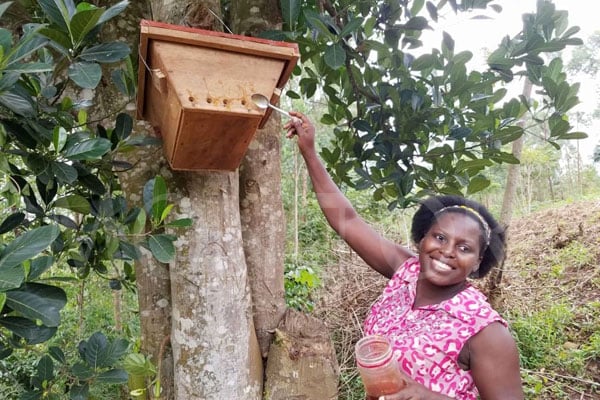Prime
There is more to beekeeping than just honey

To attract the bees to the hives, a farmer must use beeswax, which is placed in a groove made on the inside of each frame. Photo | Isaac Kasamani
What you need to know:
- Ezra Mapeera harvests at least 500 kilogrammes of honey after every four months when the conditions are right and sells at Shs30,000 each, all of it in less than two weeks.
At exactly 9am, Ezra Mapeera, an apiculturist or beekeeper in Katungulu village, Rubirizi District sets out in his protective gear to inspect the beehives at Queen Elizabeth National Park.
They are about 100 hives he says and occupy half an acre which is approximately 50meters of the 4 acre piece of bee farm land at the park.
“We do not go to the hives during the night and neither early in the mornings in order to co-exist with the wild animals amidst the safe hours of the day which is between 9 and 5pm,” he says.
“We are always on the lookout for snakes, elephants and buffalos. On arrival we observe if the Antelopes are near which would indicate that the lions are not within,” says Mapeera. For the elephants, the expert opens the hives to dispatch the bees which irritates them off the premises. “The snakes are intimidated by the smokers that we throw around the bush that causes them to flee as they enjoy to feast on bees,” he says. With about 300 bee farmers, the Orchids House Farm has created an organic taste in honey products which is richly inspired by the natural vegetation at the Park. Here the expert shares insights on bee keeping as a sentimental and productive farming experience.
Colony
The beehive is a potential haven for a colony. This gives it an organisational and political control such as that of the British Empire.
Similar to the royal family, the hive is under the influence of one Bee queen who governs the few male bees called drones and the worker bees.
According to Mapeera, all the members in the hive work together to create a strong colony. He explains,
“The quantity of honey is dependent on the size of the colony. It takes about four months of harvest for a strong colony and over eight months for a weak one.”
The hive also adopts a secretive instinct in operational frameworks as that of the Royal family. Here, the worker bees carry out secret moves in nurturing the next queen by feeding it with a special royal jelly. To ensure a strong colony, the bee farmer carries out a bee census.
He tips, “During the hive inspection, we check how active the bees are and also give it a chance and time to grow for the next 8-10months for the inactive hives. The apiarist creates an enabling environment that evokes activity among bees.” He says, “In areas with good weather and foliage or vegetation, the hive can grow fast in the attempt that they are attracted by the flowering to pollinate them.”
Structure
To start with, the size and feel of the beehive will influence enormous activity among bees hence enhancing a strong colony and faster harvests.
“Firstly, the structure requires just not any kind of wood but rather pine timber because it is accommodative and does not repel bees,” says Mapeera.
He also encourages bee farmers to measure the dimensions to enable them make appropriate sheltering that keeps in the warmth and a sense of safety.
However, he notes when picking out materials, the costing on other accessories such as net, nails and iron sheets is a tops for the start and totals up to Shs120,000 for each hive.
Methods
For a safe and user friendly product collection, a number of mechanisms are taken into account.
The beekeeper shares an approach that guides bee famers on collection mechanism which he says is assuring of good quality honey.
He says, “In the event that you are trying to open the hive, it is safe to approach it with an air tight bucket and protective gear.”
To ensure collection of ripe honey, he advises bee farmers to look out for an entrance filled with propolis and cut it out with a sharp knife to open up the seal. He shares, “The bees seal the entrance of honey combs to protect it from being invaded in harvesting.” The ripe honey he adds is kept by the bees for up to a century.
Benefits
The first suggestive benefit offered from beekeeping as a venture is the small input after investment.
“The capital is usually high especially with accessing the required materials except for the other costs that follow suit because all that is left is regular inspection of the hive. Sill as a venture, bee keeping offers a range of products from medicinal to lucrative that survive the market. “Apart from honey, the practice produces propolis, pollen, royal jelly, pollination and wax,” he lists. Among the treatment products from beekeeping is bee venom which he shares kills some strong viruses and is used in treatment of ulcers and other infectious diseases such as respiratory and skin infections.
Dangers
Bees, just like animals, can kill people and are disastrous to life. Mapeera cautions bee farmers on healthy practices that safe guard them on farm.
He says, “There should be proper handling of equipment and protective wear which is done through training.”
The expert recommends farmers to be knowledgeable while handling bees by putting in practise their training as a guide for them. Mapeera also envisions the practice growing into an important livestock venture such as poultry.
High quality honey
He starts harvesting the honey at about midnight because at that hour, he says, the bees are unlikely to get ‘angry’ and sting him.
He discourages farmers from smoking the insects as this sometimes compromises the quality of the honey. “When farmers smoke the hives to harvest honey, there are high chances of having smoke residue in the honey which is not good for the taste of the overall product.”





